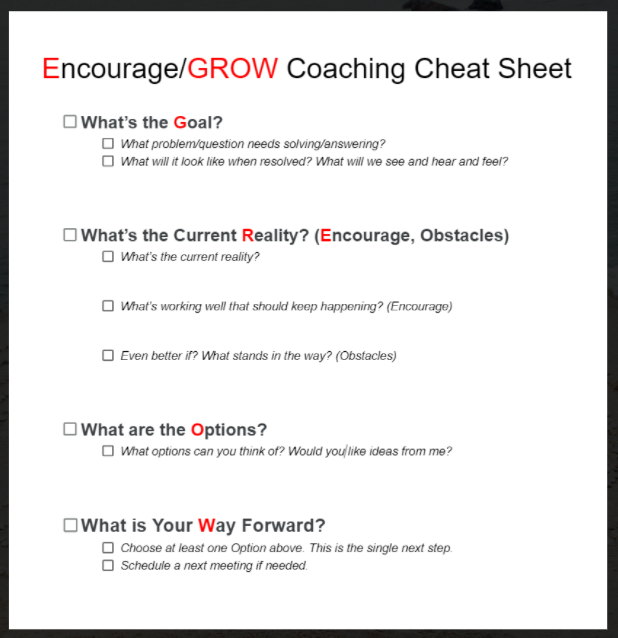Three Situations, One Tool
Alicia had a problem. Her co-worker, Fred, would gripe to her constantly, complaining about this issue or that problem in his work. Alicia was getting worn down.

Carlos, a supervisor, also had a problem. One of his team members kept coming to him, asking how to do this or asking what she should do next, like she was always unsure and afraid to act on her own.

And a General Manager, Rochelle, had a problem with worker performance. One worker in particular. No matter how many times she talked to him, he kept making the same mistakes. He’d improve at first, but the mistakes would come back.

Three problems, but the same tool can solve them all. That tool is a simple but powerful method that you can use to coach ANYONE. And I mean anyone: your mentee, your co-worker, your child, your spouse, even your boss.
Encourage and GROW
The acronym for it is E/GROW, which stands for Encourage and GROW. When you see a performance gap, lack of ownership, or uncertainty, use Encourage and GROW to get answers and jumpstart change. In my opinion, it’s the world’s easiest way to coach.
It’s as simple as asking four questions:
G: What’s the Goal?
R: What’s the current Reality?
O: What Options do you have?
W: What’s your Way Forward?

Notice that when you ask these questions, you’re not telling them anything! The best coaching is just brilliant questions that tap their thoughts and feelings and encourage their initiative.
These questions are laid out in the Encourage and GROW Cheat Sheet, which adds a few helpful sub-questions. This is the link. bit.ly/E-GROW

I recommend using this checklist the first few times you coach, to help you master the process. (And by the way, if you do fill it out, it will make it easy to certify your practice at the end of this chapter.) Let’s dive briefly into each of the questions so you understand their magic.
What’s the Goal?
“What’s the Goal?” Do they have a crystal-clear picture in their mind of what needs to happen? Can they remember it? If you ask them to describe it, it will stick in their mind more vividly. What will they see, hear, smell, taste, and feel when they succeed?
If they were just griping, this one question (“what’s the goal?”) shifts their thinking from inward and backward to forward and outward, focusing on solutions more than problems.
By the way, if someone is griping, I don’t recommend starting with this goal question, because their heart probably isn’t at peace yet. They may need some quick validation first. Some empathy. Identify their emotion, like, “Man, you sound angry,” then immediately offer some justification for their emotion, like “I don’t blame you. I’d be upset too if that happened to me.” These two simple steps help their heart calm down. 90 seconds max.

Or, if your heart isn’t at peace, start at the beginning of the 3A’s.
Either way, when both hearts are more calm, then ask the goal question. You don’t have to say it verbatim, either. I recommend changing it up, like: “What would you like to see?” “What are you hoping for?” “What do you recommend?” “What should it look like?” There are a lot of ways to ask, “What’s the Goal?”

What’s the Current Reality?
“What’s the Current Reality?” You can also ask this a lot of ways: “What’s happening now?” “Where is it at?” “How far along are we?”
Don’t forget the “encourage” part of this question. Ask them what’s working well—or point it out—so they see the bright spots and know what they want to keep happening.
Then ask them “Even better if … what?” “What stands in the way?” or “What needs to change?” This helps them see the obstacles. Focusing on the next obstacle, and then the next, is the fastest way to find a solution. Even faster than focusing on the goal alone.
What Options Do You Have?
“What Options do you have?” Ask this question to get their thinking cap on, to get them looking for solutions. This flexes the problem-solving muscles of the brain, which makes them stronger, and that makes the person more self-reliant.
If they’re still stuck and they want some advice, you’re right there to brainstorm with them. This is where you can offer options, NOT just one perfect solution that they need to follow.
What Is Your Way Forward?
“What is your way forward?” This question completes the transformation. They make a choice, and now they are facing forward towards the goal, with a next step.
They choose, not you. If they choose, then it’s their baby, not yours. They get to own it and make it happen and feel the satisfaction of their own success. THEY realize that THEY are good enough and strong enough to accomplish things, to overcome obstacles, and to make great things happen, which makes them lean more on themselves instead of depending on you forever.
This coaching method is pure magic. As you use it, you’ll empower yourself and others to do amazing things. Entire companies have been created to do nothing more than teach workers this method. But you can master it in a day. The more you practice it, the better you’ll get at asking these kinds of questions in a casual, stealthy, non-confrontational way.

By the way, remember: if the people around you are part of an empowering organization, you shouldn’t need special permission or a neon sign saying that you can coach them. Anytime someone comes to you with a concern in their area, or if they’re struggling to own something that’s theirs, it’s an invitation to coach. They signed up for coaching when they accepted the job!
That’s because empowering organizations are built on empowering leadership. Everyone uses the Leadership Steps, which includes coaching. It’s not just for bosses. So, don’t hesitate to coach anyone, anytime, with Encourage and GROW.